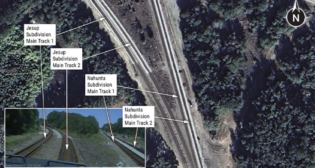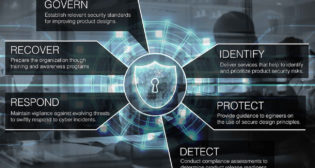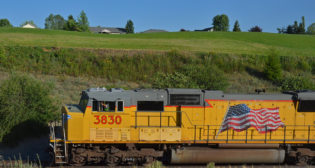
AAR to Senate panel: PTC deadline unrealistic. Here’s why
Written by William C. Vantuono, Editor-in-Chief“Due to both technological and non-technological challenges that have arisen throughout the implementation process, the current 2015 deadline should be extended by at least three years, to Dec. 31, 2018, with flexibility given to the Secretary of the Department of Transportation to consider additional extensions should they be deemed necessary,” Hamberger said.
“A lot of progress toward implementing PTC has been made to date, and railroads are working extremely hard to meet the 2015 deadline, collaborating with federal regulators and suppliers all throughout the process,” Hamberger said. “There will be a lot of PTC implemented throughout the nation’s rail network by 2015, but there will not be a fully interoperable system in place by then. While the deadline is important and something we never lose sight of, it is paramount that we end up with a PTC system that allows for the safe passage of both passengers and freight.”
 “Positive train control is an unprecedented technological challenge,” Hamberger said. “Such a system requires highly complex technologies able to analyze and incorporate the huge number of variables that affect train operations. For example, the length of time it takes to stop a train depends on train speed, terrain, the weight and length of the train, the number and distribution of locomotives and loaded and empty freight cars on the train, and other factors. A PTC system must be able to take all of these factors into account automatically, reliably, and accurately to safely stop the train.”
“Positive train control is an unprecedented technological challenge,” Hamberger said. “Such a system requires highly complex technologies able to analyze and incorporate the huge number of variables that affect train operations. For example, the length of time it takes to stop a train depends on train speed, terrain, the weight and length of the train, the number and distribution of locomotives and loaded and empty freight cars on the train, and other factors. A PTC system must be able to take all of these factors into account automatically, reliably, and accurately to safely stop the train.”
PTC development and implementation includes “a daunting array of tasks that railroads must perform,” Hamberger said. These include:
• A complete physical survey and highly precise geo-mapping of the 60,000 miles of railroad right-of-way on which PTC technology will be installed, including geo-mapping of nearly 474,000 field assets (mileposts, curves, grade crossings, switches, and signals).
• Installing PTC technology on approximately 22,000 locomotives. • Installing approximately 36,000 wayside interface units (WIU) that provide the mechanism for transmitting information to locomotives and the train dispatching office from signal and switch locations.
• Installing PTC on nearly 4,800 switches in non-signaled territory and completing more than 12,300 signal replacement projects at locations where the existing signal equipment cannot accommodate PTC.
• Developing, producing, and deploying a new radio system and new radios specifically designed for the massive data transmission requirements of PTC at 4,200 base stations, 33,700 trackside locations, and on approximately 22,000 locomotives.
• Developing back office systems and upgrading dispatching software to incorporate the data and precision required for PTC.
• Installing more than 20,000 new antenna structures nationwide to transmit PTC signals.
“Freight railroads have enlisted massive resources to meet the PTC mandate,” Hamberger said. “They’ve retained more than 2,200 additional signal system personnel to implement PTC, and to date have collectively spent approximately $3 billion of their own funds on PTC development and deployment. Class I freight railroads expect to spend an additional $5 billion before development and installation is complete. Currently, the estimated total cost to freight railroads for PTC development and deployment is around $8 billion, with hundreds of millions of additional dollars needed each year after that to maintain the system.”
Hamberger noted that another obstacle to making the 2015 deadline is the Federal Communications Commission’s (FCC) regulatory process for constructing and placing PTC antenna structures. “Railroads need to install more than 20,000 new antenna structures nationwide to transmit PTC signals,” Hamberger noted. “Almost 97% of these will be relatively small poles installed on railroad rights-of-way. According to the FCC, all PTC antenna structures are subject to the National Environmental Protection Act and National Historic Preservation Act. Under FCC rules, every PTC antenna could be subject to a separate environmental evaluation process. If every one of the 20,000-plus antennas needs to be reviewed separately, we can assume that PTC deployment will be further delayed.”
For example, according to the FCC, as part of each environmental evaluation, railroads must provide certain information on each antenna structure (height, location, etc.) to historic preservation officers within state governments and Native American tribes (depending on where the antenna structure will be installed) so that the state or tribe can determine if the installation will negatively impact areas of historic, cultural, or religious significance. Notice of the construction must even be provided to tribes that do not currently reside along the railroad right-of-way but who have previously expressed interest in the county in which the antenna structure will be installed.”
“On May 15 of this year, representatives of the railroads met with FCC staff to discuss the PTC antenna issue,” Hamberger said. “The railroad representatives explained why the FCC’s current approval process is unworkable for a deployment on the scale of PTC in the timeframe mandated by the RSIA and FRA’s rules. Meanwhile, the FCC staff stated that railroads should not construct any antenna structures for PTC that have not gone through the complete environmental evaluation process, including tribal notice, while they consider ways to streamline the state and tribal approval processes. The railroad industry, the FRA, and the FCC are consulting to try to find a workable solution that will protect the interests of Native American tribes and allow the timely deployment of PTC. While the AAR is hopeful that a solution can be found, today construction of antenna structures is on hold. If our efforts with the FCC and the FRA cannot reach a workable solution to avoid antenna-by-antenna review, the timeline for ultimate deployment of PTC will be delayed.”
In his testimony, Hamberger also emphasized the “massive private investments in safety enhancing infrastructure and maintenance on such things as tracks, new equipment, as well as employee training and cutting edge technologies, that have helped make our nation’s railroads safer than ever in their history. This unwavering focus on safety is evident in the industry’s continuously improving safety record, with 2012 registering as the safest year ever for freight railroads.”
“Why are railroads safer than ever before? Because they are investing more than ever before to grow and maintain their network,” Hamberger said. “Investments and maintenance work totaling $25.5 billion this year are being made in things that make the railroads much safer. Safety permeates everything railroads do—from decisions in the boardroom, to work along the tracks, in rail yards, or shop floors, to training in classrooms and on simulators. Everything we do is done in the name of improving safety.”
According to Federal Railroad Administration data, between 1980 (when the industry was partially deregulated under the Staggers Act) and 2012, the train accident rate fell 80%, the employee injury rate fell 85%, and the grade crossing collision rate fell 82%. Since 2000, the declines have been 44%, 51%, and 45%, respectively. According to the Bureau of Labor Statistics, railroads also have lower employee injury rates than all other modes of transportation.
“Virtually every aspect of rail operations is subject to strict safety oversight by the FRA,” Hamberger said. “Among many other areas, railroads are subject to FRA regulation regarding track and equipment inspections, employee certification, allowable operating speeds, and the capabilities and performance of signaling systems. Hundreds of FRA personnel perform regular inspections of rail facilities and operations throughout the country. In many states, FRA safety inspectors are supplemented by state safety inspectors. Railroads are also subject to safety oversight by additional federal agencies, including the Occupational Safety and Health Administration, the Pipeline and Hazardous Materials Safety Administration, and the Department of Homeland Security.”



